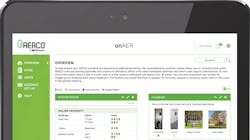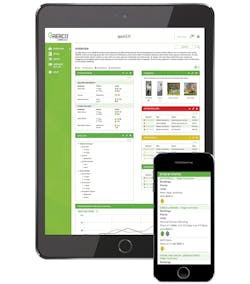Remote Monitoring: Optimizing Performance, Safety and ROI, Thanks to the Power of Data
Engineers and facility managers constantly strive to optimize their boiler systems in order to increase performance and efficiency while reducing downtime and unscheduled maintenance. A critical tool that can help them achieve this is remote monitoring.
A remote monitoring system provides real-time health-of-system performance via the cloud so personnel can analyze key boiler data remotely from their home, central office, or any other location. Timely e-mail alerts that detail when system performance falls out of established parameters allow issues to be strategically and pro-actively addressed to minimize impact and prevent unplanned shutdowns. In fact, systems such as the one shown in the image at right typically reduce total lifecycle cost of a system by 10 to 20 percent, including savings in service and labor, efficiency losses and operational costs.
Remote monitoring is more important than ever during these critical times with the COVID-19 pandemic. Not only will it help maximize system performance, it will also help keep personnel safer by reducing time on-site performing diagnostics, analysis and service.
Remote Monitoring is Much More than a BMS
Although most facilities have a Building Management System (BMS), they may only receive five to 10 critical application data points and basic equipment stats for their boiler. So they would need to pay additional money to program performance analytics. However, a typical boiler has as many as 250 data points which a BMS does not capture.
By capturing a full set of data points and built-in performance analytics, remote monitoring enables significantly more analysis to be performed and gives engineers a much stronger, more comprehensive understanding of how their system is truly performing. The result is the ability to better optimize their system and to detect potential issues. That allows facility managers to take a more predictive maintenance approach to maintain system health and optimum performance, as well.
Informed Decisions Lead to More Efficient Maintenance
Using a remote monitoring system developed by the boiler manufacturer also enables facility managers to make more informed decisions and perform maintenance more efficiently. Remote access allows skilled personnel to evaluate data and provide instruction to staff without the team having to go to the facility to investigate the situation. If no service technician is onsite, the technician dispatched still has insight about the problem before arriving.
Armed with performance and fault details ahead of time, technicians can arrive to the site equipped with the tools, parts and knowledge necessary to efficiently return the system back to optimal performance level quckly. This also eliminates costly return trips to complete the service and it expedites maintenance and repairs.
Designated facility personnel can access the data on an ongoing basis, in addition to when a real-time alert is sent. Furthermore, remote monitoring alerts inform facility mangers about a fault or decline in equipment performance, which allows them to take immediate action in order to pro-actively resolve issues quickly.
If a non-critical problem is observed through remote monitoring, personnel can solve it on their own time and schedule service when it’s most convenient. This will minimize any disruptions to the facility, its operations and its occupants.
The most effective systems can connect facility personnel with representatives authorized by the boiler manufacturer. Because these factory-trained technicians also have access to real-time data, they can locate the problem and offer expert guidance to the in-house staff on how best to correct the issue. This level of technical assistance can be done remotely, which helps reduce downtime while maintaining social distancing protocols.
Historical Data Enables Predicative Maintenance
Because a remote monitoring system is cloud-based, as in the image at right, critical historical data is always at the fingertips of facility staff, as well as accessible to the trained technicians who are on call. This eliminates unnecessary multiple trips to the site to retrieve the system history, diagnose the problem and outline potential solutions, all saving valuable time and money.
Specifically, technicians are able to review archived data to see performance over time in order to recognize patterns that fall outside routine behavior and then isolate the issue. Pro-active maintenance can then be performed preventing more serious and costly problems from developing thus reducing downtime. Considering that so many incidents happen off-hour, considerable operational savings can be realized.
For example, if a system is stressed at 6 a.m. every day, the corresponding data will be recorded by the remote monitoring system. Facility staff and respective factory-authorized technicians can evaluate the environment’s characteristics at that time to determine the cause. By doing so, a pre-emptive repair or maintenance can be performed before the equipment fails. That level of insight can only be achieved with constant monitoring and data collection.
Increased Operational Benefits and Savings
Having instant, remote access to unit performance details, event history, maintenance schedules, and other analyses allows facility personnel to improve their boiler system’s efficiency and performance, and thus their return on investment (ROI). Energy-saving opportunities can be identified through remote monitoring multiple data points, including efficiency, cycles per hour, O2 levels, and temperature readings.
With access to this data and ongoing analyses, remote monitoring can reduce unscheduled maintenance, and prevent unnecessary wear-and-tear on equipment, as well as premature failure, thereby ultimately reducing cost of ownership.
Conclusion
A remote monitoring system is an extremely useful tool that can help ensure a facility’s boiler system operates at peak performance and maximum efficiency while reducing maintenance and downtime. While it is particularly beneficial in today’s environment where COVID-19 demands social distancing and other safety restrictions, a remote monitoring system is a critical tool for increasing a boiler’s ROI in any setting.
Founded in 1949 as Angelery Engineering Research Co., AERCO was acquired by WATTS in 2014. Today, it continues to manufacture commercial condensing boilers and water heaters.


